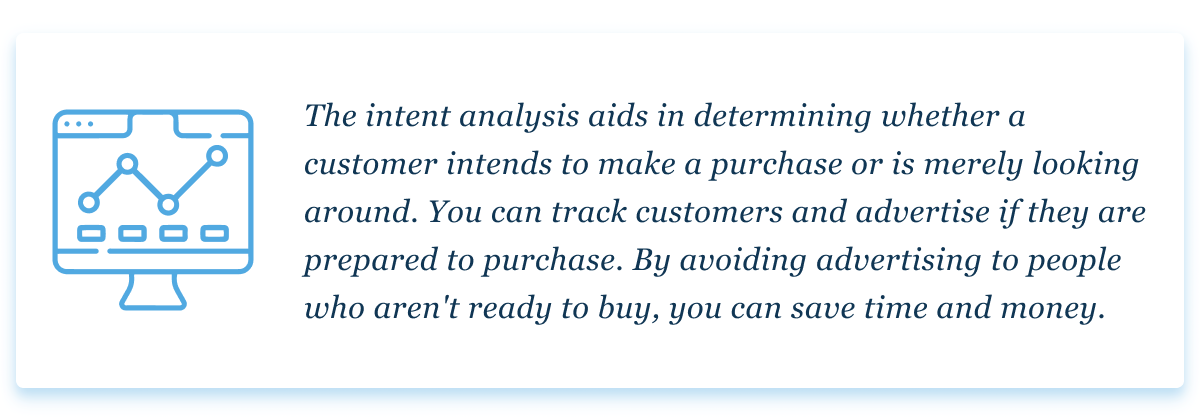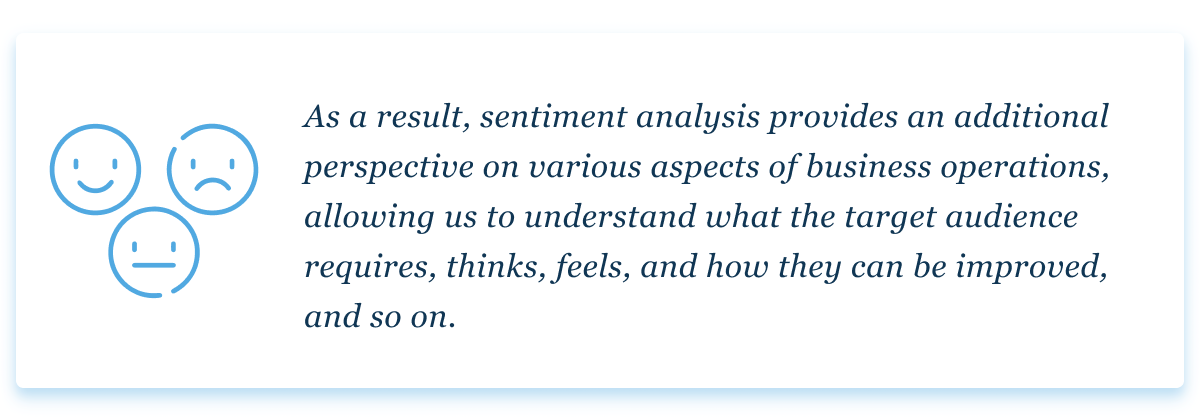Trust is one of the most crucial components in business success, but it is not always easy to build. Businesses must comprehend their clients’ needs and act accordingly. They can distinguish and classify people’s feelings about their brand, products, and services thanks to developing technology like sentiment analysis.
Let’s see business use cases of sentiment analysis and its real-world examples in depth.
What is sentiment analysis?
The automated process of examining text to ascertain the sentiment expressed (positive, negative, or neutral) is called sentiment analysis. Monitoring social media, managing customer support, and studying customer feedback are typical applications of sentiment analysis.
Observing social or public data is primarily utilized to comprehend customer satisfaction, social popularity, and general public comment on a product. Unstructured text can be sorted by emotion and opinion using machine learning techniques for natural language processing (NLP).

Perhaps you’d like to track brand sentiment on social media in real-time and over time so that you can identify and respond to disgruntled customers as soon as possible.
The applications of sentiment analysis are endless. By enhancing customer experience and service outcomes, customer sentiment analysis can increase customer loyalty and retention.
Types of sentiment analysis
People experience many emotions, including sadness and happiness, interest and disinterest, and positive and negative feelings. There are various sentiment analysis models available to capture this range of emotions.
You must comprehend the various types of sentiment analysis to know how to use it in your business operation.

Fine-grained sentiment analysis
In fine-grained sentiment analysis, the polarity of the opinion is determined. Simple binary differentiation of positive and negative sentiment can be used. Depending on the use case, this type may also enter the higher specification (for example, very positive, positive, neutral, negative, or very negative) (for example, as in five-star Amazon reviews).
Emotion detection sentiment analysis
Emotion detection, as its name suggests, aids in emotion recognition. These emotions include rage, sadness, joy, gratification, fear, worry, and panic. Lexicons, or collections of words that express particular emotions, are frequently used by emotion detection systems.

Source: Unsplash
Some sophisticated classifiers also use robust machine learning (ML) algorithms. People express their emotions in various ways, so using ML instead of lexicons is advised. For instance, consider the phrase, “This product is about to kill me.” This sentence might convey feelings of panic and fear. A similar but entirely different and uplifting meaning can be found in the phrase, “This product is killing it for me.” But the word “kill” might be linked to dread or panic in the lexicon. This could result in improper emotion detection.
Aspect-based sentiment analysis
It goes further. Its goal is to convey a viewpoint on a particular product component. It aids in identifying the specific aspects that people are talking about. Consider this: You produce mobile phones and read a customer review saying, “The camera struggles in artificial lighting conditions.” The aspect-based analysis enables you to ascertain that the reviewer made a “negative” comment about the “camera.”
This type of customer review sentiment analysis is frequently used in product analytics to monitor how customers perceive the product and to identify its strong and weak points.
Intent-based sentiment analysis
Companies can save time, money, and effort by correctly identifying customer intent. Businesses frequently chase after clients who have no immediate plans to make a purchase. This problem can be solved by accurate intent analysis.

Why is sentiment analysis important for businesses?
Sentiment analysis tools produce insights into how businesses can improve customer service and experience.
Businesses can use it to better understand how their consumer base responds to a specific service or product. By quantifying, monitoring, and automating attitudes gathered from reviews, ratings, social media, chats, or other feedback techniques, businesses may immediately react to potentially flawed features or services. Businesses can also decide more quickly and precisely and with greater knowledge.

AI-powered text analysis examines the frequency of particular terms, phrase structures and patterns, and even punctuation. This information is used to calculate the text’s overall sentiment. Most customer feedback analytics software with this feature categorizes each text as good, negative, or neutral. Some tools even offer a score or percentage to indicate how positive or negative it is.
Because it functions like an omniscient being updating you on what your customers or potential customers are saying about your product or market, more and more companies are incorporating it into their business strategies. It can go a step further by explaining why they are saying it. This can help you improve your products and services or even find inspiration for new products with a market.
5 Business use cases for sentiment analysis
Any business can use sentiment analysis to learn more about customers’ thoughts and feelings. But to successfully implement this strategy, it’s crucial to comprehend the explanation of how to do so. Here are some sentiment analysis use cases and their real-world examples.

Source: Unsplash
Reputation management – brand sentiment analysis
The most widespread application of sentiment analysis in various markets is brand monitoring and reputation management. It makes sense that understanding how consumers view your brand, product, or service would be helpful to tech companies, advertising agencies, clothing companies, media companies, and many other businesses.

Source: Unsplash
The sentiment analysis application adds more flexibility and knowledge to how the brand and its products are presented. It enables businesses to:
- Track how customers view the brand.
- Draw attention to the specifics of the attitude.
- Find patterns and trends.
- Pay close attention to the influencers’ presentations.
This enables us to present the product appropriately and adapt to the current situation.
Example – How is KFC doing it?
KFC is an excellent illustration of how to apply sentiment analysis to brand building and monitoring. While the competition was moving forward and reinventing itself with narratives about healthy food and positive experiences, KFC was still stuck in the past.

Source: Unsplash
KFC had decided to leverage the brand’s ubiquity rather than trying to carve out a place in the crowded niche. KFC began using popular culture iconography and memes to spread its brand’s value proposition.
This strategy creates natural brand traction that is strengthened by pop culture references. Users interact with the brand, eventually encouraging them to interact with the product. Sentiment analysis comes into play when you must respond and adapt almost immediately.
Product analysis
Reputation management is the root cause of sentiment analysis’ use in product analytics. It shares many conceptual similarities with brand monitoring. But it focuses on specific comments and remarks about the product and its performance in particular areas rather than brand mentions (user interface, feature performance, etc.).
This insight is crucial during the MVP’s (Minimum Viable Product) early stages when you must test the product with real users to ensure it is as polished as possible.
At this point, gathering and classifying feedback for future improvements is the most fundamental application of sentiment analysis. The grunt work of determining what type of feedback originates from which audience segment and where it points can be done by a sentiment analysis algorithm.
The entire thing is typically divided into the following categories:
- Brand terms
- Brand adjacent keywords
- Client’s needs
- Customer sentiment
- Competitor analysis
This can therefore play a significant role in the product’s successful launch on the market.
Example – How is Google using it?
Google’s output is an outstanding example of how sentiment analysis applications may help improve products. Take, for instance, the Chrome browser.

Source: Unsplash
The development team at Google Chrome constantly monitors direct or indirect user feedback (i.e., presented in the open sources, most notably, blogs).
However, they do not consider feedback as a message from the user but rather as the sum of its parts:
- The sentiment itself (positive or negative)
- Mentions of specific aspects of the product, such as scalability, extensions, security, or user interface
- Sentiments, desires, and suggestions about the product in general and its specific elements.
Voice of customer analysis
A successful business operation depends on accurate target audience segmentation and subsequent value proposition creation. You must understand where you are aiming and with what.
On the other hand, you need to maintain your finger on the pulse of your client if you want to stay relevant and keep your product in demand. Understanding the “Voice of the Customer” is at the heart of both activities.
However, simply recording and analyzing the customer’s voice is insufficient. It is dispersed across various platforms and presented in multiple contradictory forms. This needs to be carefully thought out.
Customer sentiment analysis algorithms can more precisely record and interpret customer voice.
There are two steps to the process:
- During market research, sentiment analysis can be utilized to look into general target audience segments. It can help define and further explain what a particular market segment needs and wants, what they anticipate from similar products, and which products are preferred or currently being used in the market segment.
- In terms of the product, sentiment analysis can examine both direct and indirect client feedback from numerous channels. You can examine consumer usage patterns and determine the effects on your business.
Example – How is Tripadvisor using it?

TripAdvisor is a good example of VOC analysis done right.
To maximise the value of the enormous amount of data it generates, the company uses aspect-based sentiment analysis. The aspect-based approach enables the extraction of viable points concerning customer feedback and the service itself.

Finally, providing them with what they require contributes to further polishing the service and strengthening customer engagement.
Market research competitor analysis
Aside from brand impression and consumer opinion research, market research is arguably the most common application of sentiment analysis. It’s important to remember that sentiment analysis isn’t the only tool available for market research. However, it can provide an additional perspective on the market and valuable insights into how the state of things is perceived from the ground level, i.e., by consumers.

Source: Unsplash
You can also use a similar approach to analyze the competition and their marketing efforts. Here are a few instances of what sentiment analysis can be used:
Obtain information from various platforms:
- Content created by users (comments, reviews, etc.)
- Influencer content
- News Article
- Competitor’s content
Extract numerous insights based on various criteria:
- General perception
- Perception of the specific aspect
Fill gaps in business intelligence:
- Sentiment analysis can help you understand the needs and desires of your customers and adjust your value proposition so that it hits all the right notes.
Example: How is Apple doing it?
How Apple presents and establishes its products on the market is an excellent example of sentiment analysis used for market research and competitor analysis.

Source: Unsplash
Consider how well the product’s strong points fit the general pains and dissatisfaction of the various user segments.
As an example:
- Bad design – you don’t even have to think when you use our products.
- Poor privacy – we use personal data as little as possible.
- Low battery life – we have resource management tools.
Such things can be identified by analyzing competitors and their market movements in general in terms of specific aspects. As an example:
- The brand’s value proposition
- Addressing a variety of issues
- Including new features
- Announcing milestones, etc.
A combination of this information from various sources maps out the market situation. It allows for calculating a new perspective on differentiating and strengthening its value proposition.
Customer support-feedback analysis
In real life, customer support is one of the most visible aspects of sentiment analysis applications.
There are several approaches to implementing consumer sentiment analysis:
Insight into customer perceptions of the product:
- The overall impression of the product, whether positive or negative.
- Aspect-based – about specific product elements.
- Reaction to the service – whether or not it is effective. More detailed analyses of specific aspects, such as response time or interaction quality, may also be included.
- Automating processes by implementing intent analysis will allow routine queries, like frequently asked questions and information on how a product is used, to be handled automatically.
- Customer prioritization and workflow management. For instance, suppose you have a dissatisfied customer whose ticket is prioritized to be processed as soon as possible.

Source: Unsplash
Example-how are big tech companies using it?
Big tech companies are the most visible examples of using sentiment analysis in customer support.
Consider how detailed and responsive the troubleshooting quizzes from Microsoft or Apple products are. They are designed to elicit as much information as possible from the user. It serves a dual purpose: it solves a problem while providing additional insight into the peculiarities of the product’s use. Thus, the business can continuously identify its products’ and associated services’ advantages and disadvantages and steadily raise their quality.
Conclusion
We hope this article has provided you with an in-depth guide to sentiment analysis and how to apply it to your business. Everything from brand monitoring to market research and human resources can benefit from sentiment analysis. Companies use it to gain deeper insights, boost their competitiveness, and better comprehend their clients.
What aspects of your brand do consumers like or dislike? What aspects of your product are their favorites? What areas need the most improvement? What do they think of the customer service offered by your business? These are just a few questions that sentiment analysis can answer.
Power up your business with sentiment analysis
Trying to understand what your customers think of your brand and improve your products and services? Contact us, and we’ll consult you on NLP and sentiment analysis solutions development.



